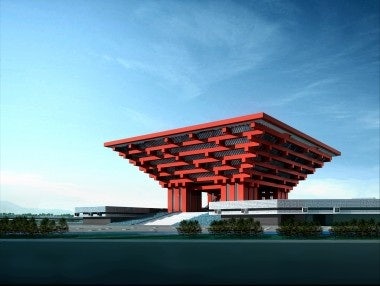City Sets Ambitious Goal To Open 16 New Museums By 2015#

The China Pavilion Will Reopen as the China Art Palace next fall
Shanghai may be known as a city obsessed with the pursuit of money, but in recent years China's most populous metropolis has busied itself with another obsession: rivaling Beijing as a cultural and artistic hub. As Jing Daily noted this past May, while Beijing still enjoys its status as China's cultural and political capital, the city's rampant growth over the past decade has cannibalized many of its vibrant arts districts and threatened many others, alienating the creative community and, in some cases, pushing artists to relocate.
This shift in Beijing, and Shanghai's well-capitalized initiative to foster a more creative environment in the city, has invigorated Shanghai's cultural ambitions. Over the last few years, new creative/lifestyle venues like 1933 (a restored Jazz Age abattoir), the Shanghai Songjiang Creative Studio, and the Rockbund Art Museum have opened their doors. Though red tape and fly-by-night private gallery owners continue to plague the industry, by 2015, Shanghai plans to open 16 more large-scale museums and galleries.
As Shanghai Daily writes this week, one of these 16 planned museums and galleries, the massive "China Art Palace," is attracting particular attention. For the art "Palace," the China Pavilion from last year's Shanghai World Expo is being transformed into an art museum "on a par with the Metropolitan Museum of Art in New York and the Musee d'Orsay in Paris," according to a senior official. From the article:
The China Art Palace will collect top-level art from home and abroad, primarily to showcase the origins and development of China's modern arts.
It is part of a plan by the city government to build 16 new major museums and art galleries and many smaller museums by 2015 and make Shanghai an "international cultural metropolis," said Zong.
"In the future, Shanghai residents will be able to find a museum and cultural venue within a 15-minute walk of their homes," she said.
"The number and quality of art galleries and museums is an important measure of cultural standing - cities such as New York and Paris are famed for their top-level galleries," said Teng Junjie, art director of the Shanghai Municipal Administration of Culture Radio Film and TV.
The palace, which will cover an area of 70,000 square meters, will open on a limited basis next October, Zong said.
Most facilities from the former China Pavilion can be retained, bringing considerable savings, she said.
The three levels of the former main exhibition hall of the Expo pavilion will showcase the history and development of modern art of Shanghai and China, while the former joint pavilion for Chinese provinces and municipalities will have separate exhibition rooms for famous Chinese modern artists, including top Shanghai painter Cheng Shifa, said Teng.
As Teng Junjie added this weekend, the aim for cultural officials is to establish three major museums in the city by 2015: "the existing Shanghai Museum, the Shanghai Art Palace and the China Contemporary Art Museum - for historic, modern and contemporary artworks." But, large scale public projects aside, more museums and galleries won't do much to transform Shanghai into a cultural hub to rival New York, Paris or even Beijing unless, as Jing Daily pointed out earlier this month, the regulatory environment for private museums and galleries is transformed as well.